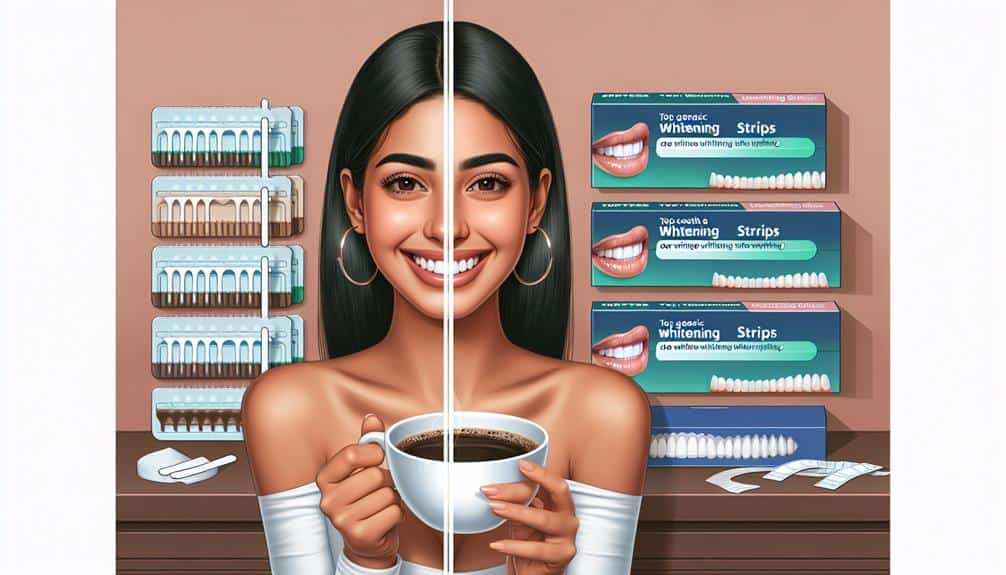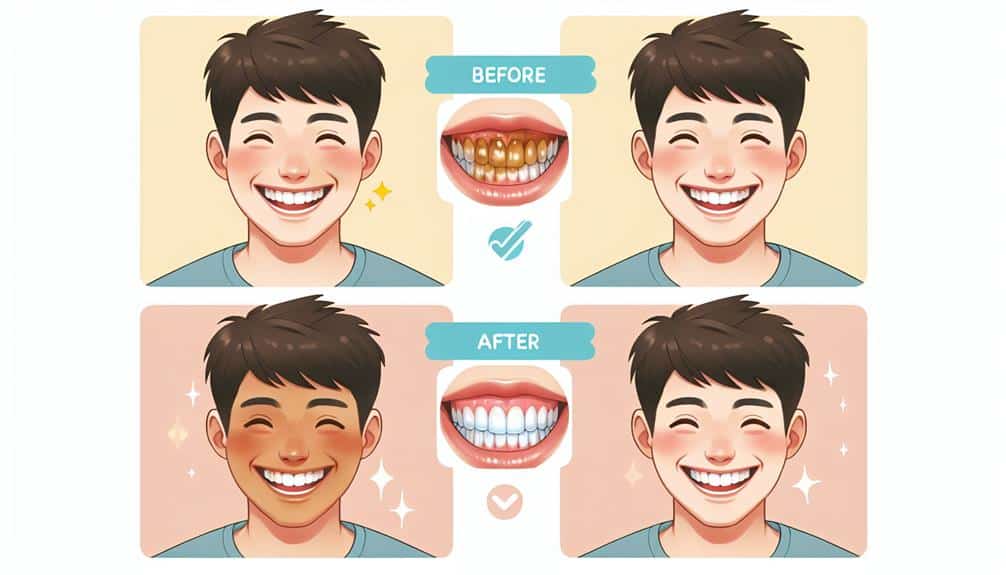If you're dealing with stubborn coffee stains on your teeth, top whitening strips can help restore your smile. Look for strips that target coffee stains, fit your lifestyle, and work best for your needs. Recommendations include Crest 3D White Professional Effects Whitestrips for effectiveness, Oral-B 3D White Whitestrips for custom molding, and Sensodyne Pronamel Gentle Whitening Strips for enamel care. Follow instructions closely for best results. Choosing the right strips tailored for coffee stains can make a significant difference in brightening your smile. Additional information on whitening strips and usage tips are available to aid your quest for a brighter, stain-free smile.
Key Points
- Look for whitening strips designed to target coffee stains specifically.
- Consider the application technique and fit to your lifestyle.
- Choose strips that work best for your needs and preferences.
- Check user reviews for real-life experiences with products.
- Follow instructions carefully for optimal results.
Benefits of Whitening Strips
When using whitening strips, you can expect noticeable improvements in the brightness of your teeth. These strips are a popular choice in cosmetic dentistry for enhancing dental hygiene by effectively removing stains and discoloration. Whitening strips contain bleaching agents like hydrogen peroxide or carbamide peroxide, which penetrate the enamel to lighten the teeth's color.
Consistency is key when using whitening strips, as they require regular application over a period of time to achieve best results. Most strips are designed for daily use, typically for a few weeks. It's essential to follow the instructions provided to prevent potential gum irritation or tooth sensitivity.
Whitening strips offer a convenient and cost-effective method to enhance your smile without the need for expensive dental treatments. They can improve the appearance of your teeth, boosting your confidence and overall dental aesthetics. Remember, while whitening strips are effective, maintaining good oral hygiene practices is vital for long-term dental health and the longevity of your whitening results.
How Coffee Stains Teeth
Coffee stains teeth due to its high acidity and dark pigments that can easily adhere to the enamel, causing discoloration over time. The acidity in coffee weakens the enamel, the outer layer of the tooth, making it more susceptible to staining. Additionally, the dark pigments in coffee, known as tannins, can bind to the enamel, leading to yellow or brown discoloration. Frequent coffee consumption exacerbates this effect, as the more often your teeth are exposed to coffee, the more likely stains are to develop.
Maintaining good dental hygiene is essential in combating coffee stains. Brushing your teeth after consuming coffee can help remove some of the staining compounds before they set in. Using a whitening toothpaste or attending regular dental cleanings can also aid in preventing and reducing coffee stains. However, even with diligent dental care, long-term coffee consumption can still lead to discoloration. This is where whitening strips can be beneficial in restoring the natural brightness of your teeth affected by coffee stains.
Choosing the Right Whitening Strips
To effectively address coffee stains on your teeth, selecting the appropriate whitening strips is vital for achieving the best results. When choosing whitening strips, it's important to conduct a thorough product comparison to determine which brand and type will work best for your specific needs. Look for strips that are specifically designed to target coffee stains, as they often contain ingredients tailored to break down these stubborn discolorations effectively.
Consider the application technique of the whitening strips you're evaluating. Some whitening strips require multiple steps, while others offer a more straightforward application process. Choose strips that fit your lifestyle and preferences to make sure you'll use them consistently for the recommended duration.
Tips for Using Whitening Strips
For best results, make sure to apply whitening strips properly by following these practical tips. Key application is essential to achieving a brighter smile without causing sensitivity. Start by carefully reading the instructions provided with the whitening strips.
Most strips need to be applied to dry teeth, so make sure your teeth are clean and dry before applying them. When placing the strip on your teeth, ensure it covers the surface evenly and securely. Gently press the strip to adhere it properly to your teeth.
To avoid sensitivity, it's important not to leave the strips on for longer than the recommended time. Overuse can lead to increased tooth sensitivity and potential gum irritation. If you experience any discomfort, remove the strips immediately and rinse your mouth with water.
It's also advisable to avoid consuming highly pigmented foods and drinks like coffee, red wine, and berries immediately after whitening to prevent staining. By following these tips for proper application and sensitivity prevention, you can effectively whiten your teeth while maintaining their health and strength.
Top Whitening Strips Recommendations
Consider trying out the recommended whitening strips to achieve a brighter and more confident smile. When looking for the best whitening strips, product comparisons and user reviews are essential.
Crest 3D White Professional Effects Whitestrips are a popular choice known for their effectiveness. These strips contain the same enamel-safe whitening ingredient used by dentists and provide professional-level results.
Another top contender is the Oral-B 3D White Whitestrips. These strips mold to the shape of your teeth and effectively remove years of tough coffee stains.
For those with sensitive teeth, Sensodyne Pronamel Gentle Whitening Strips are a great option. They're gentle on enamel while still effectively whitening teeth.
Always check user reviews to see real-life experiences with these products. Remember, consistency is key when using whitening strips, so follow the instructions carefully for the best results.
Frequently Asked Questions
Can Whitening Strips Be Used on Other Types of Stains Besides Coffee Stains?
Yes, whitening strips can effectively treat wine stains and tea discoloration. The active ingredients in whitening strips work to break down stains and restore the natural color of your teeth. Consistent use can help combat various types of discoloration.
Are There Any Potential Side Effects of Using Whitening Strips on Coffee Stained Teeth?
To avoid potential side effects when using whitening strips on coffee-stained teeth, follow precautions like not overusing them. Long-term results require consistent maintenance. Remember, moderation is key for a healthy and bright smile.
How Long Do the Effects of Whitening Strips Last on Coffee Stained Teeth?
To maintain the long-term effectiveness of whitening strips on coffee stained teeth, consider professional options like dental treatments or alternatives for upkeep. Regular maintenance is key to preserving the effects and ensuring lasting results.
Can Whitening Strips Help With Sensitive Teeth Caused by Coffee Stains?
To manage sensitivity caused by coffee stains, whitening strips can be a solution. They help whiten teeth while addressing discomfort. By incorporating these strips into your dental routine, you can enjoy coffee without compromising your dental health.
Are There Any Specific Dietary Restrictions to Follow While Using Whitening Strips for Coffee Stained Teeth?
While using whitening strips for coffee stained teeth, you must follow strict dietary restrictions to maximize benefits. Your commitment to a teeth-friendly diet will amplify long-term results and boost the effectiveness of the whitening process.



